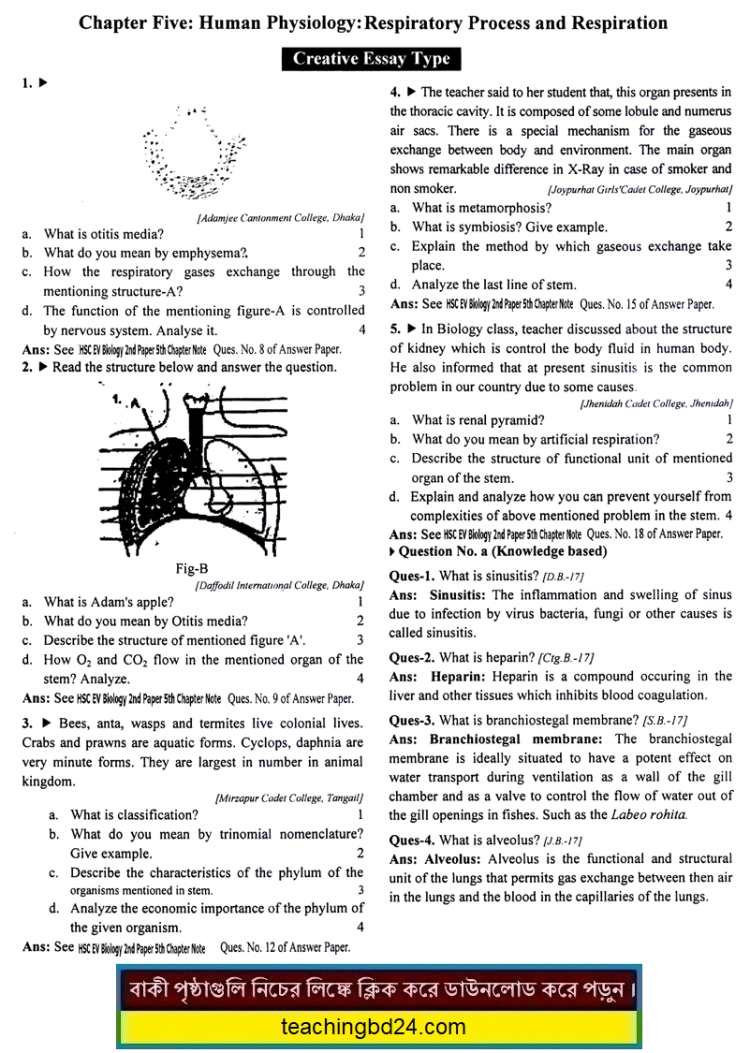EV HSC Biology II 5th Chapter MCQ Question Answer. Human Respiratory Process and Respiration. The primary organs of the respiratory system are the lungs, which function to take in oxygen and expel carbon dioxide as we breathe. The gas exchange process is performed by the lungs and respiratory system. Air, a mix of oxygen and other gases, is inhaled. In the throat, the trachea, or windpipe, filters the air. You usually don’t even notice it, but twelve to twenty times per minute, day after day, you breathe – thanks to your body’s respiratory system. Your lungs expand and contract, supplying life-sustaining oxygen to your body and removing from it, a waste product called carbon dioxide.
The respiratory system (also respiratory apparatus, ventilatory system) is a biological system consisting of specific organs and structures used for gas exchange in animals and plants. The anatomy and physiology that make this happen vary greatly, depending on the size of the organism, the environment in which it lives and its evolutionary history. Inland animals, the respiratory surface is internalized as linings of the lungs. Gas exchange in the lungs occurs in millions of small air sacs called alveoli in mammals and reptiles, but atria in birds. These microscopic air sacs have a very rich blood supply, thus bringing the air into close contact with the blood.
These air sacs communicate with the external environment via a system of airways, or hollow tubes, of which the largest is the trachea, which branches in the middle of the chest into the two main bronchi. These enter the lungs where they branch into progressively narrower secondary and tertiary bronchi that branch into numerous smaller tubes, the bronchioles. In birds, the bronchioles are termed parabronchi. It is the bronchioles or parabronchi that generally open into the microscopic alveoli in mammals and atria in birds. Air has to be pumped from the environment into the alveoli or atria by the process of breathing which involves the muscles of respiration.
EV HSC Biology II 5th Chapter MCQ Question Answer. Human Respiratory Process and Respiration

EV HSC Biology 2nd Paper MCQ Question With Answer

Biology is the natural science that studies life and living organisms, including their physical structure, chemical processes, molecular interactions, physiological mechanisms, development, and evolution. Botany, also called plant science(s), plant biology or phytology, is the science of plant life and a branch of biology.
The fields within biology are further divided based on the scale at which organisms are studied and the methods used to study them: biochemistry examines the fundamental chemistry of life; molecular biology studies the complex interactions of systems of biological molecules; cellular biology examines the basic building block of all life, the cell; physiology examines the physical and chemical functions of the tissues and organ systems of an organism, and ecology examines how various organisms interrelate.
A botanist, plant scientist or phytologist is a scientist who specializes in this field. Zoology is the scientific study of animals. This discipline can include animal anatomy, physiology, biochemistry, genetics, evolution, ecology, behavior, and conservation.
The proper function of human bodies is dependent on smaller structures, or organs, such as the heart or lungs. The tiny cells that make up these organs actually contain within them smaller structures called organelles. These organelles help the cells to perform their jobs. In cancer, changes to these organelles can cause the individual cells and ultimately the entire organism to have serious problems. To get a better understanding of how cells work, we will now spend some time examining some of these subcellular structures.
The organelles that we will discuss are involved in the information flow within cells and in energy production. In addition, we will look at a structure that gives cells their shape and allows them to reproduce themselves. All of the organelles and processes to be discussed have direct relevance to cancer because these are the cellular structures/activities that become disturbed in the disease.
The image below shows two living mouse cells. The mitochondria are colored red and the nuclei (with brightly stained chromosomes) are colored blue. The green colored region near the nuclei of the cells represents the Golgi apparatus, an organelle involved in the processing and packaging of molecules within the cell.
teachingbd24.com is such a website where you will get all kinds of necessary information regarding educational notes, suggestions and question patterns of schools, colleges, and madrasas. Particularly, you will get here special notes of physics that will be immensely useful to both students and teachers. The builder of the website is Mr. Md. Shah Jamal who has been serving for 32 years as an Assistant Professor of Physics at BAF Shaheen College Dhaka. He expects that this website will meet up all the needs of Bengali version learners /students. He has requested concerned students and teachers to spread this website home and abroad.
EV HSC Biology 2nd Paper MCQ Suggestion Question Answer
Discover more from Teaching BD
Subscribe to get the latest posts sent to your email.

